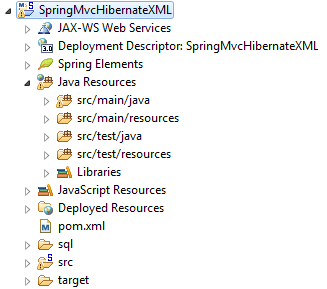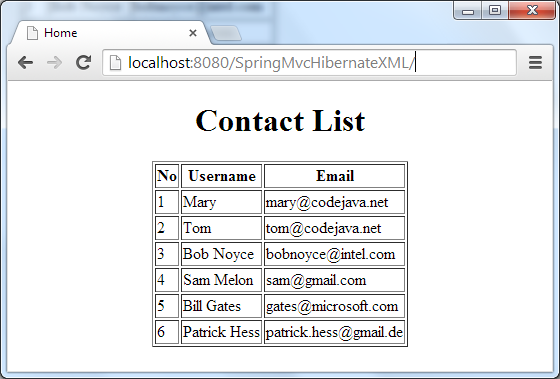Spring and Hibernate Integration Tutorial Part 1: XML Configuration
- Details
- Written by Nam Ha Minh
- Last Updated on 21 June 2019 | Print Email
- Spring MVC: Annotations for controller and XML for bean definitions.
- Hibernate: XML mapping for model class.
- Web Application: using web.xml deployment descriptor file.
- Java 7
- Spring framework 4.0.3.RELEASED
- Hibernate ORM 4.3.5.Final
- Spring Tool Suite IDE 3.5.1
- Maven 3
- Tomcat 7
1. How Spring supports Hibernate Integration
Basically, in order to support Hibernate integration, Spring provides two key beans available in the org.springframework.orm.hibernate4 package:- LocalSessionFactoryBean: creates a Hibernate’s SessionFactory which is injected into Hibernate-based DAO classes.
- HibernateTransactionManager: provides transaction support code for a SessionFactory. Programmers can use @Transactional annotation in DAO methods to avoid writing boiler-plate transaction code explicitly.
2. Setting up Project
Let’s create a Spring MVC project using Spring Tool Suite IDE (See example: Spring MVC beginner tutorial with Spring Tool Suite IDE), name it as SpringMvcHibernateXML.Setting up Database
create database usersdb; CREATE TABLE `users` ( `user_id` int(11) NOT NULL AUTO_INCREMENT, `username` varchar(45) NOT NULL, `password` varchar(45) NOT NULL, `email` varchar(45) NOT NULL, PRIMARY KEY (`user_id`) ) ENGINE=InnoDB AUTO_INCREMENT=16 DEFAULT CHARSET=latin1Remember to insert some dummy data for testing purspose.
Project Structure
The following screenshot shows final structure of the project: NOTE: After completing this tutorial, you will create a project structure looks like the above.
NOTE: After completing this tutorial, you will create a project structure looks like the above.Maven Dependencies
Declare versions for Java and Spring framework:<properties> <java-version>1.7</java-version> <org.springframework-version>4.0.3.RELEASE</org.springframework-version> </properties>Update pom.xml file for the following dependencies:
- Spring framework dependencies:
<dependency> <groupId>org.springframework</groupId> <artifactId>spring-context</artifactId> <version>${org.springframework-version}</version> </dependency> <dependency> <groupId>org.springframework</groupId> <artifactId>spring-webmvc</artifactId> <version>${org.springframework-version}</version> </dependency> <dependency> <groupId>org.springframework</groupId> <artifactId>spring-orm</artifactId> <version>${org.springframework-version}</version> <type>jar</type> <scope>compile</scope> </dependency> - Hibernate ORM framework dependencies:
<dependency> <groupId>org.hibernate</groupId> <artifactId>hibernate-core</artifactId> <version>4.3.5.Final</version> </dependency>
- Java Servlet and JSP dependencies (for compilation only):
<dependency> <groupId>javax.servlet</groupId> <artifactId>javax.servlet-api</artifactId> <version>3.1.0</version> <scope>provided</scope> </dependency> <dependency> <groupId>javax.servlet.jsp</groupId> <artifactId>javax.servlet.jsp-api</artifactId> <version>2.3.1</version> <scope>provided</scope> </dependency>
- JSTL dependency:
<dependency> <groupId>jstl</groupId> <artifactId>jstl</artifactId> <version>1.2</version> </dependency>
- Apache Commons DBCP dependency (for database connection pooling):
<dependency> <groupId>org.apache.commons</groupId> <artifactId>commons-dbcp2</artifactId> <version>2.0</version> </dependency>
- MySQL Connector Java dependency (JDBC driver for MySQL):
<dependency> <groupId>mysql</groupId> <artifactId>mysql-connector-java</artifactId> <version>5.1.30</version> </dependency>
3. Coding Model Class Configuring Hibernate Mapping
Writing Model Class
Create a new class named User.java in the package net.codejava.spring.model with the following source code:package net.codejava.spring.model;
public class User {
private int id;
private String username;
private String password;
private String email;
// getters and setters are removed for brevity
}This model class is used to map the table users and the database to a plain-old Java object (POJO).Creating Hibernate XML Mapping for the Model Class
We need to create a Hibernate XML mapping file to map the User class to the users table in database. Create a User.hbm.xml file under the same package as the User class with the following XML code:<?xml version="1.0" encoding="UTF-8"?>
<!DOCTYPE hibernate-mapping PUBLIC
"-//Hibernate/Hibernate Mapping DTD 3.0//EN"
"http://www.hibernate.org/dtd/hibernate-mapping-3.0.dtd">
<hibernate-mapping package="net.codejava.spring.model">
<class name="User" table="USERS">
<id name="id" column="USER_ID">
<generator class="native"/>
</id>
<property name="username" column="USERNAME" />
<property name="password" column="PASSWORD" />
<property name="email" column="EMAIL" />
</class>
</hibernate-mapping>NOTE: For more information about Hibernate XML mapping, see: Hibernate One-to-Many XML Mapping Example.Creating Hibernate XML Configuration File
Create hibernate.cfg.xml file under the root of classpath (right in src directory in the project) with the following XML code:<?xml version='1.0' encoding='utf-8'?>
<!DOCTYPE hibernate-configuration PUBLIC
"-//Hibernate/Hibernate Configuration DTD 3.0//EN"
"http://www.hibernate.org/dtd/hibernate-configuration-3.0.dtd">
<hibernate-configuration>
<session-factory>
<property name="dialect">org.hibernate.dialect.MySQLDialect</property>
<property name="show_sql">true</property>
<mapping resource="net/codejava/spring/model/User.hbm.xml"/>
</session-factory>
</hibernate-configuration>This Hibernate configuration file declares which resources need to be mapped (the User.hbm.xml file in this case).
4. Coding DAO Classes
Writing UserDAO interface
Create a very simple DAO interface for the User class as the following UserDAO.java class:package net.codejava.spring.dao;
import java.util.List;
import net.codejava.spring.model.User;
public interface UserDAO {
public List<User> list();
}This interface declares only one method list() that retrieves all users from the database.Writing UserDAO implementation
Here’s we code an implementation of the UserDAO interface, the UserDAOImpl class as follows:package net.codejava.spring.dao;
import java.util.List;
import net.codejava.spring.model.User;
import org.hibernate.Criteria;
import org.hibernate.SessionFactory;
import org.springframework.transaction.annotation.Transactional;
public class UserDAOImpl implements UserDAO {
private SessionFactory sessionFactory;
public UserDAOImpl(SessionFactory sessionFactory) {
this.sessionFactory = sessionFactory;
}
@Override
@Transactional
public List<User> list() {
@SuppressWarnings("unchecked")
List<User> listUser = (List<User>) sessionFactory.getCurrentSession()
.createCriteria(User.class)
.setResultTransformer(Criteria.DISTINCT_ROOT_ENTITY).list();
return listUser;
}
}Notice in this class, a Hibernate’s SessionFactory object is injected via constructor by Spring. The list() method simply obtains the current session from the SessionFactory and queries for a list of all users in the database.Pay attention to the @Transactional annotation provided by Spring - when a method is annotated by this annotation, Spring will inject transaction support code into the method - thus we don’t have two write any code to handle transaction explicitly. 5. Configuring Spring Application Context
Now, we come to the most important part that wires Spring and Hibernate together through some XML configuration. Open the servlet-context.xml file under src/main/webapp/WEB-INF/spring/appServlet and update its content as follows.Configuring Spring MVC View Resolvers
As usual, add the following declarations for Spring MVC annotation driven approach:<mvc:annotation-driven /> <mvc:resources mapping="/resources/**" location="/resources/" /> <context:component-scan base-package="net.codejava.spring" />The following declaration for a common view resolver that converts logical view names to actual JSP pages:
<bean class="org.springframework.web.servlet.view.InternalResourceViewResolver"> <property name="prefix" value="/WEB-INF/views/" /> <property name="suffix" value=".jsp" /> </bean>
Configuring DataSource Bean
We use Apache Commons DBCP for a data source with connection pooling capability:<bean id="dataSource" class="org.apache.commons.dbcp2.BasicDataSource" destroy-method="close"> <property name="driverClassName" value="com.mysql.jdbc.Driver"/> <property name="url" value="jdbc:mysql://localhost:3306/usersdb"/> <property name="username" value="root"/> <property name="password" value="secret"/> </bean>NOTE: Change database URL, username and password according to values in your environment. This data source will be injected to a SessionFactory bean below.
Configuring SessionFactory Bean
Spring 4 provides support for Hibernate 4’s SessionFactory through a LocalSessionFactoryBean which is actually a FactoryBean that creates a Hibernate’s SessionFactory which is then injected to Hibernate-based DAO beans. Here’s the bean declaration:<bean id="sessionFactory" class="org.springframework.orm.hibernate4.LocalSessionFactoryBean"> <property name="dataSource" ref="dataSource" /> <property name="configLocation" value="classpath:hibernate.cfg.xml" /> </bean>Note that this LocalSessionFactoryBean requires a DataSource bean which is declared previously. The configLocation property specifies where Hibernate configuration file will be searched for. In this case, it is the hibernate.cfg.xml file in the classpath.
Configuring TransactionManager Bean
The following declaration is for automatic transaction support for the SessionFactory:<tx:annotation-driven /> <bean id="transactionManager" class="org.springframework.orm.hibernate4.HibernateTransactionManager"> <property name="sessionFactory" ref="sessionFactory" /> </bean>As mentioned in the UserDAOImpl class, we can specify transaction support by using the @Transactional annotation for transaction-aware methods.
Configuring DAO Bean
And finally, configuration for our UserDAOImpl bean - pretty simple:<bean id="userDao" class="net.codejava.spring.dao.UserDAOImpl"> <constructor-arg> <ref bean="sessionFactory" /> </constructor-arg> </bean>This bean will be then injected to a Spring MVC controller class which is described below.NOTE: For the whole content of Spring application context configuration file, see the corresponding file in the attached project.
6. Coding Controller Classes
Write our Spring MVC controller class (HomeController.java) under the net.codejava.spring package with the following code:package net.codejava.spring;
import java.util.List;
import net.codejava.spring.dao.UserDAO;
import net.codejava.spring.model.User;
import org.springframework.beans.factory.annotation.Autowired;
import org.springframework.stereotype.Controller;
import org.springframework.web.bind.annotation.RequestMapping;
import org.springframework.web.servlet.ModelAndView;
/**
* Handles requests for the application home page.
*/
@Controller
public class HomeController {
@Autowired
private UserDAO userDao;
@RequestMapping(value="/")
public ModelAndView home() {
List<User> listUsers = userDao.list();
ModelAndView model = new ModelAndView("home");
model.addObject("userList", listUsers);
return model;
}
}Here, an implementation of the UserDAO is injected automatically by Spring (because @Autowired annotation is used). Remember the UserDAOImpl bean we declared in the Spring application context configuration file previously? It is injected to this controller automatically so that the handling method home() can use it to list all users from the database. And eventually, the home() method returns a view named home which is resolved an actual JSP page which is described below.
7. Coding View Page
Create a home.jsp under the src/main/webapp/WEB-INF/views directory with the following content:<%@page contentType="text/html" pageEncoding="UTF-8"%>
<!DOCTYPE HTML PUBLIC "-//W3C//DTD HTML 4.01 Transitional//EN"
"http://www.w3.org/TR/html4/loose.dtd">
<%@ taglib uri="http://java.sun.com/jsp/jstl/core" prefix="c" %>
<html>
<head>
<meta http-equiv="Content-Type" content="text/html; charset=UTF-8">
<title>Home</title>
</head>
<body>
<div align="center">
<h1>Contact List</h1>
<table border="1">
<th>No</th>
<th>Username</th>
<th>Email</th>
<c:forEach var="user" items="${userList}" varStatus="status">
<tr>
<td>${status.index + 1}</td>
<td>${user.username}</td>
<td>${user.email}</td>
</tr>
</c:forEach>
</table>
</div>
</body>
</html>This JSP page simply displays a list of users which is passed by the controller, by using JSTL tags. 8. Testing the Application
Deploy the SpringMvcHibernateXML application on Tomcat server and access its default page via the following URL:http://localhost:8080/SpringMvcHibernateXML
If everything is going fine, you would see the following result: Congratulations! You have completed our first part of Spring-Hibernate Integration series. You can download the attached project and experiment yourself. A deployable WAR file is also provided for your convenience. References:
Congratulations! You have completed our first part of Spring-Hibernate Integration series. You can download the attached project and experiment yourself. A deployable WAR file is also provided for your convenience. References: Related Spring-Hibernate Integration Tutorials:
- Spring and Hibernate Integration Tutorial Part 2: Java-based Configuration
- Spring MVC + Spring Data JPA + Hibernate - CRUD Example
- Struts - Spring - Hibernate Integration Tutorial Part 1 - XML Configuration
- Struts - Spring - Hibernate Integration Tutorial Part 2 - Java-Based and Annotations
Other Spring Tutorials:
- Understand the core of Spring framework
- Understand Spring MVC
- Understand Spring AOP
- Spring MVC beginner tutorial with Spring Tool Suite IDE
- Spring MVC Form Handling Tutorial
- Spring MVC Form Validation Tutorial
- Spring MVC with JdbcTemplate Example
- Spring MVC + Spring Data JPA + Hibernate - CRUD Example
- 14 Tips for Writing Spring MVC Controller
About the Author:
 Nam Ha Minh is certified Java programmer (SCJP and SCWCD). He began programming with Java back in the days of Java 1.4 and has been passionate about it ever since. You can connect with him on Facebook and watch his Java videos on YouTube.
Nam Ha Minh is certified Java programmer (SCJP and SCWCD). He began programming with Java back in the days of Java 1.4 and has been passionate about it ever since. You can connect with him on Facebook and watch his Java videos on YouTube.
Comments
@Autowired
private SessionFactory sessionFactory;
public Session getSession() {
return sessionFactory.getCurrentSession();
}
Cannot find class [net.codejava.spring.dao.UserDAOImpl] for bean with name 'userDao' defined in ServletContext resource [/WEB-INF/spring/appServlet/servlet-context.xml]; nested exception is java.lang.ClassNotFoundException: net.codejava.spring.dao.UserDAOImpl
org.springframework.beans.factory.support.AbstractBeanFactory.resolveBeanClass(AbstractBeanFactory.java:1327)
org.springframework.beans.factory.BeanCreationException: Error creating bean with name 'homeController': Injection of autowired dependencies failed; nested exception is org.springframework.beans.factory.BeanCreationException: Could not autowire field: private net.codejava.spring.dao.UserDAO net.codejava.spring.HomeController.userDao;